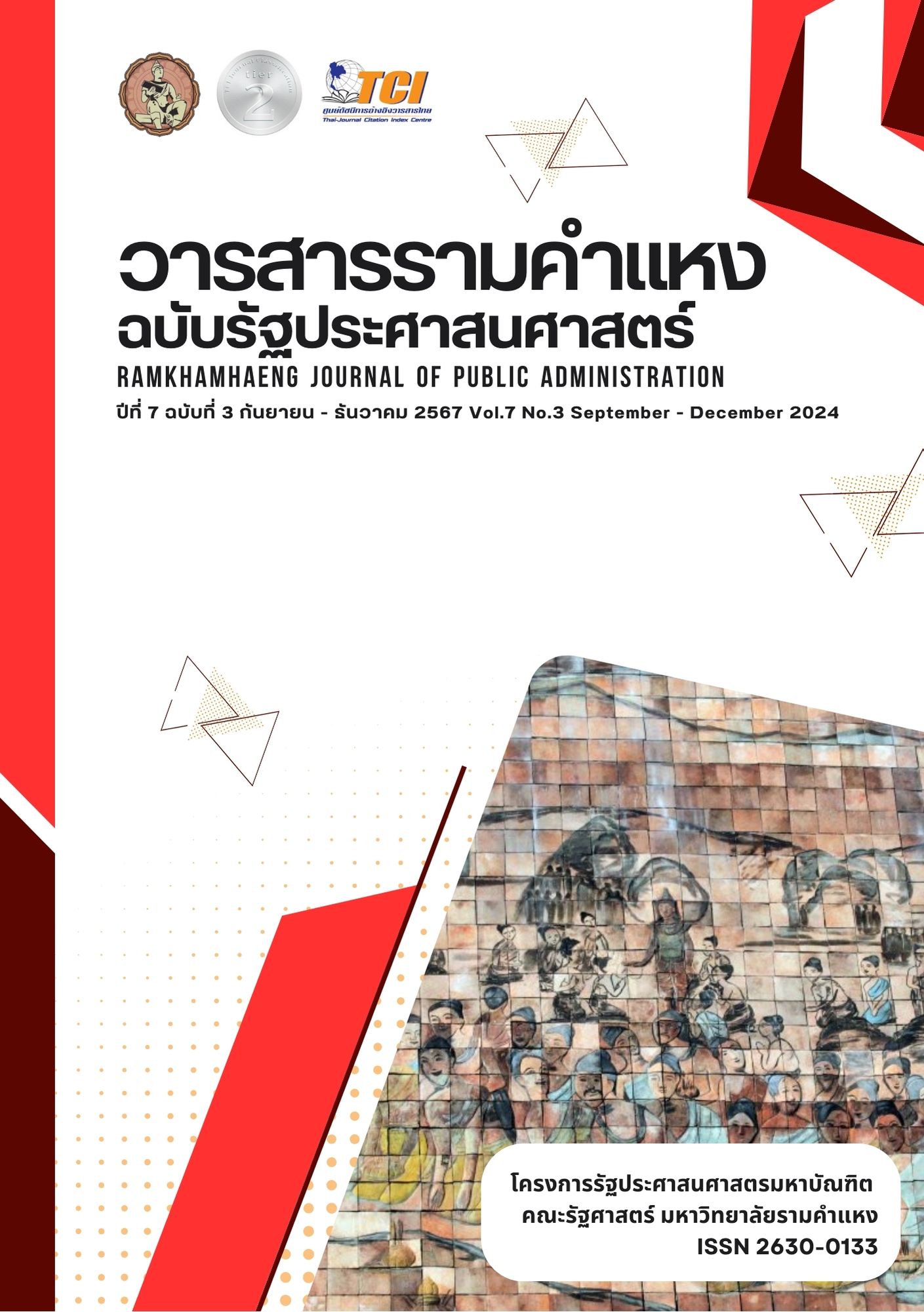The achievement of using vocabulary mnemonics devices from movies in Netflix of Suan Dusit University’s students
Keywords:
Selected:Mnemonics Devices, Image Mnemonics, English Vocabulary, Movies in NetflixAbstract
The research titled "The achievement of using vocabulary mnemonics devices from movies in Netflix of Suan Dusit University’s students" aimed to assess how effective Netflix movie-based mnemonic devices are in improving students' English vocabulary retention. The study gathered data from pre-tests, post-tests, and a retention test conducted one month later, involving students enrolled in two courses during the first semester of 2023. A mixed-method approach was used, with quantitative data analyzed through mean, standard deviation and t-test and qualitative insights gathered from interviews and focus groups. The findings showed that post-test scores were the highest (mean = 22.26), followed by retention test scores (mean = 22.11), while pre-test scores were much lower (mean = 10.44). Most students improved their vocabulary by using mnemonic devices, particularly image-based mnemonics, linking word meanings to scenes and emotions from Netflix movies. Dictation activities also played a crucial role in enhancing students' listening, writing, reading, and speaking skills. This method helped in long-term vocabulary retention and boosted students' confidence, making them more motivated to engage with English learning both inside and outside the classroom.
References
ณัฐภร อินทุยศ. (2556). จิตวิทยาทั่วไป. กรุงเทพฯ : บริษัท วี. พริ้นท์ (1991) จำกัด.
บุบผา อนันต์สุชาติกุล. (2549). การวิจัยเชิงปฏิบัติการ: วิจัยเพื่อเรียนรู้วิธีวิจัยหรือเพื่อสร้างวัฒนธรรมการเรียนรู้. เชียงใหม่: มหาวิทยาลัยเชียงใหม่.
นารีนารถ ห่อไธสง. (2555). การใช้ภาพยนตร์เพื่อพัฒนาทักษะภาษาอังกฤษ: การวิจัยปฏิบัติการรูปแบบวงจรลำดับเวลาของเจมส์ แมคเคอร์แนน (James McKernan). วารสารวัดผลทางการศึกษา มหาวิทยาลัยมหาสารคาม, 17 (1), 187 – 199.
ผู้จัดการออนไลน์. (2566). คนไทยรั้งท้าย! สกิลพูดอังกฤษ ต้องมีอะไรผิดพลาดตรงไหน ที่กระทรวงศึกษาฯ หรือเปล่า?. สืบค้นเมื่อ 12 ตุลาาคม 2567, จาก https://mgronline.com/daily/detail/9660000108214
สุธิดา โอวัฒนกุล และธารินี กิตติกาญจนโสภณ. (2559) .การเขียนตามคำบอกเป็นเครื่องมือพัฒนาประสิทธิภาพการเขียนภาษาอังกฤษของนักศึกษาในมหาวิทยาลัยเอกชน. วารสารศึกษาศาสตร์ มมร คณะศึกษาศาสตร์ มหาวิทยาลัยมหามกุฏราชวิทยาลัย, 4 (2), 179 – 206.
อรอนงค์ หิรัญบูรณะ และสุภาณี เฑียรเจริญ. (2525). บทบาทสมมติ (Role Playing). วารสารภาษาปริทัศน์, 3 (1), สืบค้นเมื่อ 30 กรกฎาคม 2567, จากhttps://www.culi.chula.ac.th/Images/asset/pasaa_paritat_journal/file-36-544-k5eapf758366.pdf
Afsharrad, M. (2014). The Effect of Transcribing on Beginning Learners Dictation. Theory and Practice in Language Studies, 10 (4), 2203-2208.
Alabsi, T. (2016). The Effectiveness of Role Play Strategy in Teaching Vocabulary. Theory and Practice in Language Studies, 6(2), 227-234.
Aliakbari, M. and Jamalvandi, B. (2010). The Impact of Role Play on Fostering EFL Learners' Speaking Ability: A Task-Based Approach. Pan-Pacific Association of Applied Linguistics, 14 (1), 15-29.
Damanik, Ivana J. and Katemba, Caroline V. (2021). College Student Perspective’ toward Netflix as Digital L2 Learning Aid on Vocabulary Improvement. The 8th International Scholars Conference, 57-66. Retrieved on October 12, 2024 from https://ejournal.unklab.ac.id/index.php/8iscared/article/view/628/582
Damanik, Ivana J. and Katemba, Caroline V. (2021). Netflix as a Digital EFL Learning Aid for Vocabulary Improvement: College Students’ Perspective. 7(2), 442 – 455. Retrieved on October 13, 2024 from https://www.scribd.com/document/620708108/2386422222
Saragih, Dhea. (2022). The Use of Dictation Strategy to Teach Listening Skill. Transformational Language, Literature, and Technology Overview in Learning, 1 (2), 1-100. Retrieved on October 13, 2024 from
file:///Users/visakhatiemlom/Downloads/Dhea+Saragih_TRANSTOOL++The+Use+Of+Dictation+Strategy+ In+Teaching+Listening.pdf
Ebbinghaus, H. (1913). Memory: A Contribution to Experimental Psychology. (H. A. Ruger & C. E. Bussenius, Trans.). Teachers College Press. Retrieved June 8, 2024, from https://doi.org/10.1037/10011-000
Ezenwosu, Ngozi E. (2011). Dictation as a Veritable Tool for Language Proficiency on Project Educational Reform in Nigeria. African Research Review, 5 (6), 18-25. Retrieved on October 13, 2024 from https://www.ajol.info/index.php/afrrev/article/view/72340
Ho, L. (2023). How to Use Spaced Repetition to Remember What You Learn. Retrieved July 30, 2023, from
https://www.lifehack.org/851026/spaced-repetition.
Katemba, C. V. (2021). Enhancing Vocabulary Performance through Mobile Assisted Language Learning at a Rural School in Indonesia. Acuity: Journal of English Language Pedagogy, Literature and Culture, 6(1), 1–11. Retrieved on October 12, 2024 from https://doi.org/10.35974/acuity.v6i1.2457
Kusnierek, A. (2015). Developing Students’ Speaking Skills Through Role-Play. World Scientific News, (7), 73-11. Retrieved on July, 2024 from www.worldscientificnews.com.
Montalvan, R. (1992). Dictation Updated: Guidelines for Teacher - Training Workshops. English Language Programs Division, Bureau of Educational and Cultural Affairs, United States Information Agency.
Nation, I.S.P. (1983). Teaching and Learning Vocabulary. English Language Institute University of Wellington.
Sadeghi, K., and Sharifi, F. (2013). The Effect of Post-Teaching Activity Type on Vocabulary Learning of Elementary EFL Learners. English Language Teaching, 6 (11), pp. 65-76.
Sawyer, J. & Silver, S. (1961). Dictation in Language Learning. Language Learning, (11), 33-42.
Thornbury, S. (2002). How to Teach Vocabulary. Essex: Pearson Education Limited.
Van Syoc, Bryc. (1963). Methods of Teaching English as a Foreign Language. Bangkok: The Social Sciences Association of Thailand Press.
Wilkins, D. A. (1972). Linguistics in Language Teaching. London: Edward Arnold. Retrieved June 26, 2023, fromhttp://www.ldonline.org/article/15577?theme=prin
Yavaslar, Erhan and Demirci, Cavide. (2018). Vocabulary Role Play : an Active Learning Strategy for Vocabulary Teaching. European Journal of Education Studies, 4 (4), 197 – 205.
Downloads
Published
How to Cite
Issue
Section
Categories
License
Copyright (c) 2024 วิสาขา เทียมลม

This work is licensed under a Creative Commons Attribution-NonCommercial-NoDerivatives 4.0 International License.



